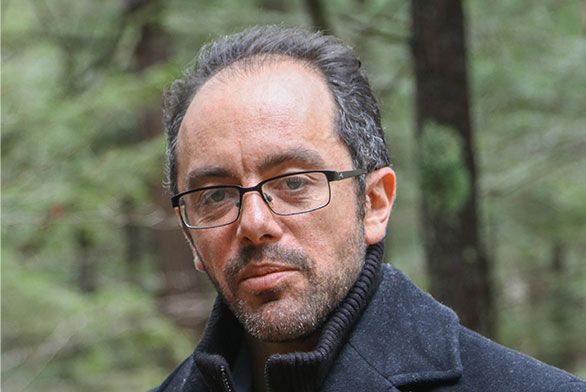Santa Fe Alum’s New Book Explains How the AR-15 Became One of America’s Most Ubiquitous—and Deadly—Guns
October 20, 2023 | By Kirstin Fawcett
Should inventors bear responsibility for the way their creations shape society? It’s the type of question Zusha Elinson (SF03) might have debated in seminar, and one at the heart of American Gun: The True Story of the AR-15. Co-written by Elinson, a longtime Wall Street Journal reporter, and his colleague Cameron McWhirter, the book traces the assault rifle’s improbable evolution from garage hobby project to mass-shooting staple.

Elinson and McWhirter cover the gun industry for the Journal and have reported on mass shootings, many of which have involved some model of the AR-15 rifle. “As we were covering these shootings,” Elinson says, “we wanted to go deeper into the story to understand: how did we get here? How did we get to this place where we’re all afraid to go out in public, where it feels like a shooting could erupt at any time?”
To fully unpack how the AR-15 had become synonymous with not just mass shootings but a vast cultural divide, a book was warranted. Published by Farrar, Straus and Giroux on September 26, 2023, American Gun has since been named one of the New York Times’ “33 Nonfiction Books to Read This Fall” and received coverage from the New Yorker, the Washington Post, and other outlets. It doesn’t provide easy takeaways for our nation’s gun discourse, but Elinson says he’s able to report on charged issues thanks in part to St. John’s College, where he “learned to ask tough questions but not judge other people,” he says. “You’re there to talk about books. You really learn to listen to what people say, and then ask them questions—all these sorts of things that are absent from political debate in our country.”
Spurred by politics and marketing, the AR-15 improbably leapfrogged from obscure military invention to consumer product favored by mass shooters in just several short decades. But its story really began during the Cold War with Eugene Stoner, a mild, self-taught engineer in Los Angeles who loved rifles, airplanes, and tinkering in his garage. In the 1950s, the patriotic ex-Marine devoted all his spare time to designing a lightweight, easy-to-shoot gun for American soldiers and their allies. Stoner succeeded, and his innovation was later adopted by troops in Vietnam; outside the military, the AR-15 was ignored for years by mainstream manufactures, hunters, and hobbyists.
Things began taking a turn in 1994 when Congress passed the Federal Assault Weapons Ban. It enraged Second Amendment activists and increased demand for the AR-15, a weapon newly viewed as a symbol of limited government. A small band of renegade gun manufacturers leaped on the bandwagon, making and selling more AR-15-type weapons than ever before. (Loopholes in the assault weapons ban allowed them to tweak the gun while preserving its lethalness.) The gun’s popularity peaked again post-9/11 as American soldiers streamed into the Middle East carrying the M-16, an automatic version of the M-15.
In the late 2000s, the assault weapon ban had long since dropped, and firearms enthusiasts and military vets routinely purchased an ever-growing supply of AR-15-style guns produced by an ever-emboldened gun industry. Then came President Barack Obama’s election. “The era launched this full-scale assault: “Obama’s coming to take everyone’s guns,’” Elinson reflects. “A lot of this was exaggerated; Obama was actually quite moderate on guns. But the effect was such that people rushed out to buy AR-15s like they never had before. It was kind of a political statement to buy this gun.”
By the time America began experiencing mass shootings with increased regularity in the 2010s, the weapon had landed on copycats' radars. Not only were the AR-15 and similar guns affordable and easy to purchase, but also “tough and martial looking,” Elinson says. “A lot of these guys are slight, not great at athletics, no girlfriends, feeling emasculated. And they also want fame: they can kill more people with this thing. They want to be remembered for killing lots of people.”
AR-15-style guns have killed countless people in the past decade alone. But Elinson and McWhirter also took care to interview the survivor of a mass shooting, Valerie Kallis-Weber. Struck by two bullets in the 2015 San Bernadino massacre, she’s undergone more than 60 surgeries, completed thousands of hours of physical therapy, and regained limited mobility while struggling with post-traumatic stress disorder. “Valerie, a really remarkable woman who overcame a lot of injuries, is in a way the living example of the power of this gun,” Elinson says.
Along the way, Elinson and McWhirter encounter policymakers, activists, and gun manufacturers in their quest for answers—and, one might hope, solutions—to America’s gun problem. All inevitably lead back to inventor Eugene Stoner, who once described his obsessive tinkering with early iterations of the AR-15 as “kind of a hobby that got out of hand.” Even if he never imagined his gun being sold in sporting goods stores, should Stoner have shown more forethought while creating a deadly new weapon?
“At the very bottom of it, this is a story that the Greeks would love to write,” Elinson says, comparing American Gun to the ancient tragedies he read at St. John’s College. “The story of the AR-15 starts off with the best intentions of this little-known inventor and ends up in a place where we are all afraid to go to the movie theater.”

